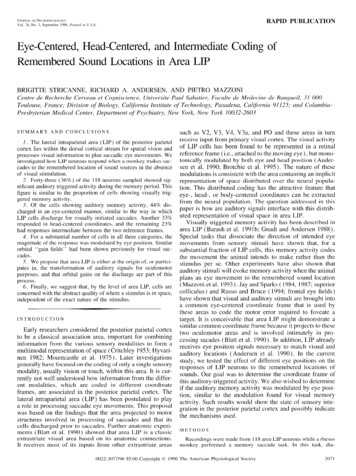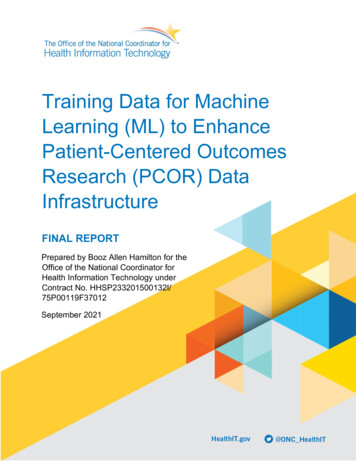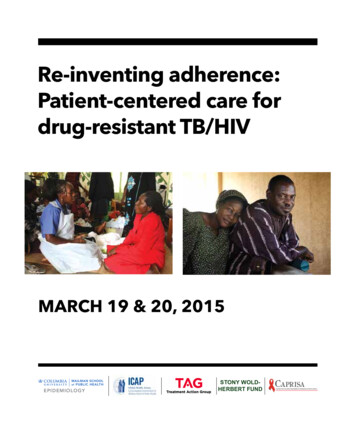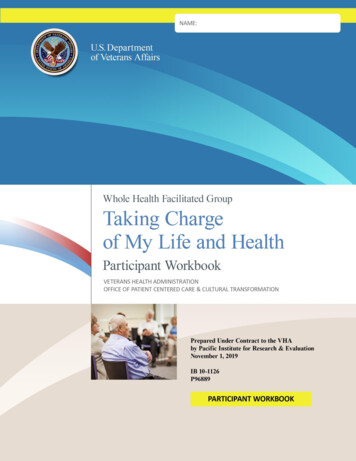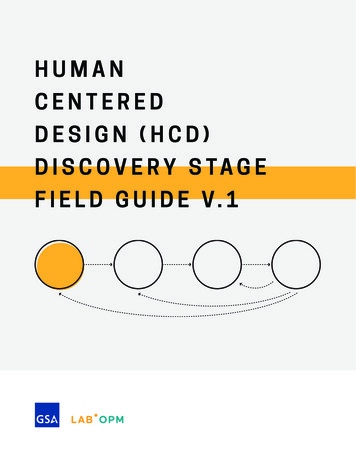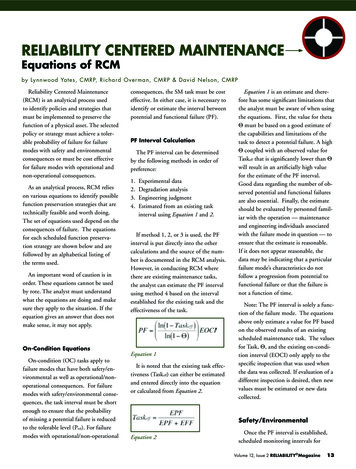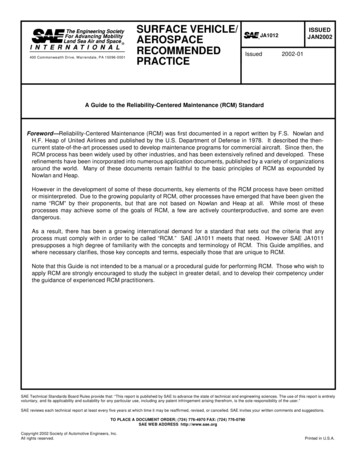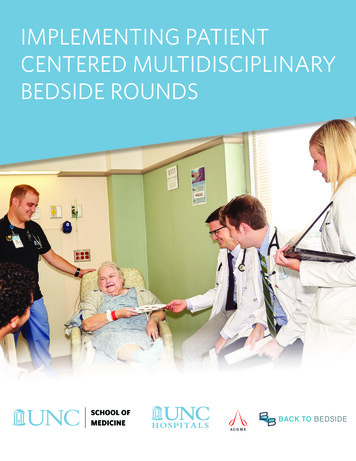
Transcription
IMPLEMENTING PATIENTCENTERED MULTIDISCIPLINARYBEDSIDE ROUNDS
TABLE OF CONTENTSBackground & Goals4Project Commencement and Sustainability5Key Stakeholders6Details of Rounding Technique6Prioritization of Patients for Bedside Rounds7Introduction of Team and Bedside Rounding Format7Team Member Expectations8Challenges & Solutions9Testimonials & Frequently Asked Questions10APPENDICESAppendix 1: Presentation Rubric for Distribution to Rounding Team 12Appendix 2: Example Scripts13Appendix 3: FaceSheets Template18Appendix 4: Bedside Rounding Cheat Sheet: Physicians20Appendix 5: Bedside Rounding Cheat Sheet: Nurses21Appendix 6: Bedside Rounding Cheat Sheet: Care Managers22Appendix 7: Bedside Rounding Cheat Sheet: Pharmacists23References24
BACKGROUNDCommunication between daily rounding teams and patients on the medicine wardsis ineffective. This is a result of numerous issues including: redundancy in thediscussion of clinical data, paucity of meaningful face time with patients, inadequatepatient engagement in their plan of care, and deficiency in a multidisciplinarypresence during daily rounds.1 These factors propagate patients’ sense ofvulnerability and a decreased sense of satisfaction with our work. Rounding withpresentations made at the patient’s bedside, rather than in the hallway or a remoteconference room, has been shown to improve patient and medical team satisfactionwithout sacrificing efficiency.2-9 Despite this, residents prefer not to present at thebedside during rounds with concerns that it will increase patient anxiety, compromiseteaching, and be inefficient.10-12 Surveys of UNC internal medicine residents, attendingphysicians, and nurses showed that patient engagement, teaching and nursinginvolvement on rounds was inadequate (Figure 1): Watch the VideoIntroduction:MultidisciplinaryBedside RoundingFigure 1: Survey Results – Perceptions of Patient Engagement, Teaching, and Nursing on RoundsGOALSThis project was developed to target these problems by restructuring rounds with a consistentmultidisciplinary team presence at the patients’ bedside to have a clinical discussion with the mostimportant team member: the patient. This new structure aims to maximize meaningful time spentwith the patient by eliminating outside the room discussions about patient care when appropriate. Themedical team will find more meaning in this valuable time spent at the bedside, learning from the patientand involving them in their own plan of care, as this is critical for sustainability of the bedside roundingtechnique.13-17 It is important to clarify that the objective of bedside presentations is not to shortenoverall rounding time, but to allow the medical team to have more meaningful time with patients. Theimplementation of multidisciplinary bedside rounds will result in improved communication between allmembers of the team. We also hope this rounds format results in timely placement consults and orders,earlier discharges and expedited documentation.3
PROJECT COMMENCEMENT ANDSUSTAINABILITYTo kick-off the project, resident, attending, nurse, and social work representatives participated in a flow-mapexercise to identify major areas of inefficiencies and dissatisfaction with current rounding methods. Discussionswere held with a patient focus group to gain a first-person perspective on sources of vulnerability. These findingswere incorporated in the re-structuring of the team rounding processes to better interface with patients.Consistent buy-in from residents and attending physicians on rounds is paramount for sustainability. In a prepilot survey of the UNC internal medicine residency, 31 out of 63 responses cited that their principal concernwith implementation of bedside rounding was that rounding time would increase. To prospectively analyze thisconcern, a time-motion study was performed to analyze the impact of bedside rounding on overall roundingduration as well as the amount of time medical teams spent face-to-face with patients. Implementation of abedside rounding strategy decreased average per-patient rounding duration from 11’45” to 9’22” (p 0.0001),and increased average time spent with patients from 4’43” to 6’31” (p 0.0001) (Figure 2). When combined,this led to a significant increase in the fraction of time spent with patients, a term referred to as the “FaceTimeFraction,” from 40.2% pre-intervention to 69.6% post-intervention.With the support of the School of Medicine as well as Hospital Operations leadership, this project wasdeveloped and piloted on one inpatient general medicine teaching service beginning in October 2017. Thispilot was successful in achieving our goals and is now being implemented across all rounding teams (with theexception of the ICU) in the Department of Medicine at UNC. 4Figure 2: Time-Motion Study ResultsPATIENT CENTERED MULTIDISCIPLINARY BEDSIDE ROUNDS
KEY STAKEHOLDERSThe key stakeholders in this project are first and foremost the patients and their families, the residents andmedical students, attendings, nurses, care managers, and pharmacists. There is also significant investment froma patient advocacy group, residency and fellow department representatives, and hospital leadership.DETAILS OF ROUNDING TECHNIQUEThe team implemented a four-phased approach to conducting daily rounds, outlined below.Pre-8:35 amPre-rounding 8:35 amPre-Round Huddle: Upper level resident leading discussion with attending, charge nurse, andcare management representative (5- 10 minutes) 8:45 – 11:00 amDetermine which patients will be rounded on as a team, and which patients will beseen by the attending and residents separatelyDecide rounding order (refer to Prioritization of Patients for Bedside Rounds)Update care managers on dischargesInterns should use this time to page consultsTeam Rounds Watch the VideoContacting nurse beforerounding on mutualpatient After 11:00 amAll members of the medical team computer pre-round on the patients includingovernight admissions (refer to Team Member Expectations)Interns and residents physically pre-round on patients, prioritizing sick ordecompensating patients, admissions, transfers and, dischargesNotify nursing staff when in transit to primary regionalized areaCharge nurse joins rounds when ableOutside patient room team touch base should occur only in certain scenarios (i.e.patient issue that cannot be discussed in front of family members)In the patients’ rooms the presenter will: Sit at eye-level with the patient Introduce bedside rounding format and roles of each team member, and give aFaceSheet to new patients (refer to Appendix 1) Present in an assessment/plan format, prioritizing patient’s active problems(refer to Appendix 2 Example Scripts) Respond to patient and caregiver questions Update white-board with the daily plan discussed (medical student or nurse) Non-presenting intern should input orders for this patient on a computer onwheels and complete an order recapAfter exiting the patients’ rooms the team should when necessary close the loop ofcommunication on the patient care planPost-rounds Attending and residents visit patients pre-determined to see separatelyRest of team input any additional orders and ensure clear on the care plan for therest of the dayIt is an expectation that attendings see stable patients outside of team rounds whichend no later than 11:00 am.5
PRIORITIZATION OF PATIENTS FORBEDSIDE ROUNDSIn the Pre-round Huddle the resident and attending will strategize the rounding order withprioritization of patients in the following order:Sick and decompensating patientsNew admissions and transfersDischargesStable patientsOn average teams spend about 10 minutes per patient, and 12-14 patients on a20-patent census is the ideal number to round on together with the multidisciplinaryteam. Watch the VideoPre-Round HuddleINTRODUCTION OF TEAM ANDBEDSIDE ROUNDING FORMATA patient-centered approach involves discussion of the day’s medical planat eye level with the patient with emphasis on engaging them in their ownmedical plan. The following is an example of how to introduce the techniqueto a patient:Watch the VideoEffectiveMultidisciplinaryBedside Rounding6“Hello Mrs. Smith, my name is Dr. Jones and I am the supervising residentdoctor on your medical team. Here is a sheet with our pictures and nameson it so that you can be more familiar with your doctors. I would like tointroduce you to [intern], [attending], [medical students], and [pharmacist].We will all be working closely with you and your nurse [nurse’s name]to come up with a medical plan for the day. We prefer to talk about yourmedical course and plan with you, rather than having these discussionswithout you present. If there are medical terms that are unclear please let usknow and we will help clarify. Please feel free to provide input, and we willlikely ask you questions as we discuss your case.”PATIENT CENTERED MULTIDISCIPLINARY BEDSIDE ROUNDS
TEAM MEMBER EXPECTATIONSAll team members are expected to computer pre-round, arrive to rounds on time, balance speaking inlayman’s terms versus medical jargon, and allow patients to interject while maintaining the focus ofrounds.Attendings:Computer pre-round on existing and newpatients, provide recommendations atappropriate times during the presentationswhile trying to minimize presentationinterruptions, ensure that full assessmentand plan based structure is utilized, andround independently on appropriatepatients established in pre-round huddle.Attendings should not schedule themselvesor be responsible for other clinical dutieswhile on service such as procedures orclinic. It is an expectation that attendingssee stable patients outside of team roundswhich end no later than 11:00 am.Residents:Computer and physical pre-round on newand sick patients, determine order of roundsand patients to be rounded on as a teamversus attending only, lead the pre-roundhuddle, introduce bedside rounding formatto patients, give new patients a FaceSheet(refer to Appendix 3), and provide inputand recommendations after the presenterhas finished.Interns:Computer and physical pre-round onpatients, assessment and plan basedbedside presentations while sitting ateye-level with the patient, engage team forinput when needed during presentations,utilize computer on wheels for orders,consults, discharges and documentationwhen co-intern is presenting their patients,and perform order recap after co-intern’spresentations.Medical Students:Computer and physical pre-round onpatients, help to locate primary nurses onrounds, assessment and plan based bedsidepresentations, ask questions when appropriate and engage team for their expertise,and update white-board in room.Charge Nurses:Participate in pre-round huddle, notifyteam of unexpected changes in patientstatus, and help to locate primary nurses onrounds.Bedside Nurses:Make reasonable efforts to be present forbedside rounds, advocate for patients,supplement important information notrelayed during the presentation, askclarifying questions, and update the whiteboard.Pharmacists:Contribute expert advice at appropriatetimes during rounds.Care manager:Make contact with primary team in themorning through phone conversation orface-to-face participation in the pre-roundhuddle to optimize use of time while teamis rounding.Factors Critical to Success Resident and attending buy-inNurse and care management participationHand out FaceSheets (refer to Appendix 3)Pre-determine of patients to use technique on with team versus have theattending and residents see separatelyTalk to the patient at eye-levelUse the workstation on wheels and stool which is stored on the workstation7
TESTIMONIALSI did NOT believe in patientcentered rounding before doingit. Now 100% changed.– InternI felt that patients reallyenjoyed the extra time androunds were pretty efficient.– ResidentFollow hospital infection control regulations:clean the stool if it becomes visibly soiled,after use in the room of a patient on Contactor Enteric Precautions, and daily after rounds.It really works -- can beefficient, save time, betterpatient engagement.”– AttendingI think the patients reallyengage more when they arepart of the conversation.– Attending[The pre-round huddle] isvery effective, the quick 5-10minutes helps me prioritize myday!– Care manager8PATIENT CENTERED MULTIDISCIPLINARY BEDSIDE ROUNDS
FREQUENTLY ASKEDQUESTIONSQ: How do I politely exit the patient room when thepatient or care partner is continuing to ask questionsthat I may not have the answer to/may not need to beanswered at this time?A: We suggest first reinforcing expectations withthe introduction of the team and the FaceSheet,explaining that our goal is to talk about the plan fortoday and then answer questions that arise frompatients and care partners. If answering certainquestions would benefit from a more extendedconversation, acknowledge the question and statethat you would like to discuss this more in-depthafter team rounds have finished.Q: How do I make the patient feel comfortable whensurrounded by such a large care team?A: The best way to make a patient comfortableis to introduce all members of the team and theirroles, and to explain the purpose and structure ofthe presentation. Patients should understand whyeach person needs to be in the room discussing theirsensitive medical information. It is also important totell the patient that they are a vital member of theteam, and encourage the patient to ask questionsand make clarifications when appropriate.Q: What is the best way to educate my department onthis technique and implement it sustainably?A: Initial contacts that are helpful for implementingmultidisciplinary bedside rounding on a particularunit is to first meet with that unit’s physician serviceleader and nurse manager. From there, educate theattending and residents teams, primary nurses, andcare managers using this multimedia curriculum.It might also be helpful to have attendings andresidents “shadow” the service leader or anotherattending who is experienced with multidisciplinarybedside rounding. Please encourage attendings whoare dissatisfied with this format to give feedback anddiscuss ways for improvement.Q: How do I ensure there is a place to sit at eye-levelwith the patient?A: The medical team was provided with a foldingstool that could hang on the side of a mobileworkstation on wheels. Our patient advisorypanel suggested that sitting on a patient’sbedside should be encouraged after askingpermission as well.Q: How do I balance in-depth discussion amongstteam members, teaching, and patient-directedconversation?A: Our patient advisory panel unanimouslyagreed that listening to their physicians havedetailed conversations about their medical careis appreciated. Learning the thought processesbehind medical decision making helps fostertrustful patient-physician relationships.Q: How do I incorporate medical students intobedside presentations?A: Medical students are encouraged to leadbedside rounding presentations just as internsand residents do. Residents and attendings areencouraged to coach the students to present amanagement plan and ask questions in the room ifquestions arise.Q: What strategies help primary nurses attendbedside rounds with the remainder of the medicalteam?A: Giving primary nurses adequate lead timebefore going into a mutual patient’s room is themost important. It is helpful to contact that unit’scharge nurse prior to the rest of the team arrivingfor rounds. Charge nurses can help alert primarynurses in addition to teams contacting primarynurses through Vocera or comparable means ofdirect communication. It helps to have a dedicatedmember of the team be responsible for contactingprimary nurses for consistency9
APPENDICES10PATIENT CENTERED MULTIDISCIPLINARY BEDSIDE ROUNDS
APPENDIX 1: PRESENTATION RUBRIC FORDISTRIBUTION TO ROUNDING TEAM8:35- 8:45 am “Pre-round Huddle” Create a patient rounding order to prioritize seeing sick/decompensating patients, admissions/transfers,and dischargesDecide what patients are appropriate for the bedside rounds format and which patients should be seenseparately by the attending physician and resident after completion of roundsUpdate care managers on dischargesInterns should use this time to page consults8:45- 11:00 am Bedside Rounds Notify the charge nurse and primary nurse for first patient via Vocera when in transit to primaryregionalized area (i.e. 8BT for Med W).Arrive to the patient’s roomPresenter sits at eye level with the patientIntroduce team members (hand out the FaceSheet to new patients) and bedside rounding formatPresent in an assessment/ plan format prioritizing the active problemsMedical student or nurse will update the white-board with the plan for the dayBedside nurse should advocate for the patient and make sure questions are answered- At the same time of the presentation, the co-intern can enter in orders for the patient on aworkstation on wheels- Perform an “order re-cap”- The team will use an “exit strategy” to return to the room for more lengthy discussions with thepatient and family members (ie goals of care discussions)11
APPENDIX 2: EXAMPLE SCRIPTSEXAMPLE OF A GOOD CASE: PATIENT ADMITTEDOVERNIGHT AND IS SEEN BY THE TEAM FOR THE FIRSTTIME[Resident calls nurse on Vocera using phone to alert themof rounds]RESIDENT: We are starting rounds in Room 8302.[Knock on door][Medical team enters room, resident gives introductionof the team and bedside rounding technique. Hands anddescribes FaceSheet to patient. Intern sits on a stool atbedside]RESIDENT: Hi Ms. Smith, I’m Dr. Williams, theresident on your medical team. You know Dr. Douglas,the intern. This is Dr. Anderson, the attending andSusan is our pharmacist. Here is a FaceSheet with ournames, photos and a description of our roles. We’regoing to be doing our rounds at the bedside, meaningwe will go over the events from overnight and the planfor today. We may use words you don’t understand,and we will do our best to define them, but please askif it is still unclear. The purpose of this type of roundsis to include you in your care plan, so please feel freeto speak up if anything is incorrect or if you have anyquestions.[Ms. Smith nods]INTERN: Ms. Smith is our 60year old woman with diabetes,heart failure with reducedejection fraction and chronickidney disease who is herefor acute kidney injury whichresulted from dehydrationfrom fluid pills and a low heartrate.[RN enters, goes to white-boardand updates while team is discussing problems]12PROBLEM #1: ACUTE ON CHRONIC KIDNEYDISEASEAssessment: You received 1 liter of saline in the pastday and we have seen an improvement your creatinine,which is a marker of kidney function. The creatinineimproved from 2.3 on admission to 1.5 today, which isnear your baseline of 1.3. On your exam this morning,I saw the JVP at 2 cm above the clavicle with the headof the bed at 60 degrees, which is a vein in your neckthat indicates that you have some extra fluid on yourheart. In addition, I also detected some mild fluid accumulation in your legs and your weight is up 0.5 kg. Youhad urine output of 1500 mL in the past 24 hours.Plan: I would like to re-start the Lasix medication andplan to give you a dose of 40 mg once this morning.Then I will re-examine you and re-evaluate your urineoutput this afternoon.[Resident and Attending nod in agreement]PROBLEM #2: HYPERTENSIONAssessment: Blood pressure has been in the160s-170s/80s overnight.Plan: I am going to discuss with my team here which ofyour home medications we should re-start since yourkidneys are still recovering.Watch the VideoEffectiveMultidisciplinaryBedside RoundingRESIDENT: This is a good question. We do not wantto re-start the lisinopril medication while the kidneysare still recovering, especially as we are planning tore-start a small dose of the Lasix today. I propose thatwe re-start your beta-blocker.PATIENT: But I thought yesterday my heart rate wastoo low for the beta-blocker.INTERN: This is a good point Ms. Smith and brings meto discuss PATIENT CENTERED MULTIDISCIPLINARY BEDSIDE ROUNDS
(CONTINUED) APPENDIX 2: EXAMPLE SCRIPTSremoving extra fluid, metoprolol XL 12.5 mg daily foryour heart, and a blood draw for a BMP tomorrowmorning to monitor your kidney function.PROBLEM #3: LOW HEART RATESAssessment: Yes, when you were admitted your heartrate was low. Overnight our heart monitor showednormal sinus rhythm with heart rates in the 80s.Plan: So, I also think it is a good idea to re-start yourhome beta-blocker today.PHARMACIST: Ms. Smith, I saw from your home medications that you take nadolol, is this correct?MS. SMITH: Yes, I have been on nadolol for years.PHARMACIST: As this medication is filtered by thekidneys, this medication accumulated in your body andcaused your heart rate to be too low. I recommend westop this medication and start a different medication inthe same drug class that is not filtered by the kidneys.RESIDENT: This was a good teaching point. Let’s starta low dose of the beta blocker metoprolol succinate. Ithink a dose of 12.5 mg is reasonable.ATTENDING: Ms. Smith, do you have any questions forus?MS. SMITH: No, this was very helpful.ATTENDING: Nurse Gigi do you have any questions?NURSE: Ms. Smith, you told me this morningthat you are confused about your home medications. Would you like someone to go overthem with you?MS. SMITH: Yes, this would be extremelyhelpful.RESIDENT: A member of our team would bemore than happy to come back after roundssometime in the afternoon to discuss yourmedications with you. Please let your nurseknow if you need anything else.[Team leaves the patient’s room]EXAMPLE OF A BAD CASE:THE TEAM DISCUSSIONIN PATIENT ROOM IS TOOBRIEF WHICH HINDERSPATIENT UNDERSTANDINGAND DELAYS APPROPRIATEMEDICAL CARE[Knock on door][Medical team enters room, stand in group at bedside, internsits in a chair. There is no nurse present]RESIDENT: Hi Ms. Smith, we’re going to be doingbedside rounding today, Dr. Douglas here will be discussing the plan for the day. Feel free to interrupt if youhave any questions.INTERN: Ms. Smith is our 60 year old woman withdiabetes, heart failure and chronic kidney disease who ishere for an acute kidney injury and bradycardia. Things seem to be getting better, you’vebeen making a good amount of urine andyour creatinine, the kidney function numberis getting closer to your baseline. We aregoing to re-start your Lasix and home beta-blocker.Watch the VideoInnefective Rounds :Discussion too BriefCO-INTERN AT THE WORKSTATION ONWHEELS: Order recap- Lasix 40 mg once to continueATTENDING: Ms. Smith, how are youfeeling? Do you have any questions for us?MS. SMITH: I feel much better. I am gladthings are going in the right direction.RESIDENT: Ok, let your nurse know if youneed anything. Have a great day.13
(CONTINUED) APPENDIX 2: EXAMPLE SCRIPTS[Team leaves the patient’s room and closes door]Outside the room the team is now discussing the plan ofthe Lasix dosing and is unclear if the patient was takingnadolol or another type of beta blocker at home. Theyplan to have the pharmacist come back after rounds tohave this discussion with the patient.EXAMPLE OF A BAD CASE:TOO MUCH MEDICALJARGON IS USED AND THEASSESSMENTS AND PLANSARE NOT ORGANIZED BYPROBLEM. THE PATIENT DOESNOT UNDERSTAND THE PLAN.cardia has resolved. She was on nadolol at home, andas this medication was not dosed for renal impairment Iwould like to switch her to metoprolol XL 12.5 mg daily.ATTENDING: That sounds like a good plan. We cancontinue to monitor urine output and evaluate dailykidney function.[Team looks at the patient]ATTENDING: Ms. Smith, how are you feeling? Do youhave any questions for us?MS. SMITH (CONFUSED): I don’t think so.RESIDENT: Ok, let your nurse know if you needanything. Have a great day.[Team leaves the patient’s room and closes door][Knocking on door][Medical team enters room, patient is eating a meal, standin group at bedside. Attending moves chair out of the way.]INTERN: So this is Ms. Smith, a 60 year old womanwith Type 2 Diabetes, heart failure with reduced ejectionfraction and chronic kidney disease who’s here for acuteon chronic renal failure from over-diuresis and symptomatic bradycardia.Watch the VideoInnefective Rounds: toomuch use of medicaljargonASSESSMENT: She had no acute events overnight, vitalsigns have been stable, urine output was adequate.Physical exam significant for moist mucus membranes,2/6 systolic ejection murmur heard best over the leftupper sternal border, clear lungs, JVP 2 cm above thethe clavicle with the head of the bed at 60 degrees, andnow 1 lower extremity edema. Labs on admission weresignificant for an elevated creatinine to 2.5 and a FeNa of0.5%. Urine microscopy was bland. For her AKI, creatinine is down-trending from 2.5 yesterday to 1.5 today,with a baseline of 1.3. Her blood pressure has been in the160s-170s/80s overnight. The bradycardia has resolvedper review of telemetry.Plan: I will re-start Lasix 40 mg daily and re-evaluate hervolume status. We will continue to hold her Lisinopril,but I plan to re-start a beta blocker now that her brady14EXAMPLE OF A BAD CASE:PATIENT CENTERED MULTIDISCIPLINARY BEDSIDE ROUNDS
(CONTINUED) APPENDIX 2: EXAMPLE SCRIPTSPATIENT IS MEDICALLYSTABLE AND SHOULD BESEEN AFTER ROUNDS BY THEATTENDING[Resident calls nurse on Vocera to alert them of rounds][Knock on door][Medical team enters room, intern sits at bedside in chair]INTERN: This is Mrs. Smith, a 42 year old woman withOSSA bacteremia. her vital signs and physical examare stable. We are getting weekly labs, which are dueon Monday. Today is day 10 of her 14 day course ofintravenous oxacillin. she will stay here for the durationof her therapy. She is receiving her antibiotics througha PICC line in her right arm which is clean and dressed.ATTENDING: OK, sounds good. Any questions, Mrs.Smith?MRS. SMITH: Nope, that pretty much sums it up.ATTENDING: Nurse GiGi, is there anything you need?RESIDENT: Ok, let your nurse know if you needanything.[Team leaves the patient’s room and closes door]EXAMPLE OF A CASEWITH SENSITIVE MEDICALINFORMATION THAT IS NOTAPPROPRIATE FOR BEDSIDEROUNDS[Outside patient room]INTERN: Like we mentioned in the pre-round huddle,Mrs. Smith’s care may be best discussed outside theroom first given the sensitive nature of her problems.Mrs. Smith is our 42 woman with osteomyelitis, whohas been medically stable, but had some events thatoccurred in the past 24 hours that we need to discussas a team. Her family is in the room this morning andwanted an update.[Whole team nods in agreement]RESIDENT: [TO OTHER INTERN]: Will you call Mrs.Smith’s nurse to join us outside the room?[Other intern calls nurse on Vocera]PROBLEM #1: FEVER AND OSSA BACTEREMIAWatch the VideoIneffective Rounds:unnecessary full teamroundingAssessment: The patient developed a fever to 38.7overnight. her other vital signs were stable, and sheis now afebrile. Two blood cultures, a urine cultureand a chest xray were obtained. The chest xray wasunremarkable. The differential includes potential newbacteremia given concerns of tampering with the PICCline or a drug fever. Given her isolated fever and clinicalstability, I agree with not starting another antibiotic.[Nurse joins]15
(CONTINUED) APPENDIX 2: EXAMPLE SCRIPTSPlan: I will follow the results of the blood and urinecultures. For now, I think we should continue the oxacillinwhich is Day 10 of the planned 14 Day course.PROBLEM #2: BEHAVIOR AND POSITIVEURINE TOXICOLOGYAssessment: Yesterday afternoon, the nurse found herlethargic and her PICC line was disconnected. A urinetoxicology was sent and has resulted positive for opiates.I am concerned that someone brought her an opiate andnow there is a potential line injection.Plan: I think we should institute a bedside sitter. I wouldlike to return to her room to discuss the positive urinetoxicology test once her family has left.[Team knocks and enter the patient’s room]RESIDENT: Good morning everyone. Mrs. Smith, couldyou tell us who’s with you today?MS. SMITH: Yes, this is my husband, Roger.for the fever that occurred last night.INTERN: Mrs. Smith you had a fever to 38.7 degreesCelsius overnight. Fortunately, the fever resolved andthe rest of your vital signs are stable. We collected bloodand urine cultures and obtained a chest xray. The chestxray showed no source for the fever. We plan to continuethe oxacillin now and follow the results of the bloodcultures.HUSBAND: Do you think the antibiotic is not working forthe infection?INTERN: That is a good question. As we saw thebacteria cleared from her bloodstream after the initiationof this antibiotic, I do think it is working. We are doing athorough evaluation for a possible new source of infection. Mrs. Smith, I would like to come back to your roomthis afternoon to have a private conversation with you.PATIENT: Thanks, can we plan to meet sometime thisafternoon?INTERN: Yes, I will see you then.RESIDENT: It’s nice to meet you. Ms. Smith, is it okay ifwe give you an update on the plan of care in front of yourfamily?[Team leaves the patient’s room]PATIENT: Yes, my husband would like to know the planWatch the VideoBedside Roundingwith Sensitive MedicalInformation16PATIENT CENTERED MULTIDISCIPLINARY BEDSIDE ROUNDS
APPENDIX 3:FACESHEETS TEMPLATENames and Faces of your DoctorsDr. Sean GaffneyIntern PhysicianDr. Rimma OsipovIntern PhysicianDr. Katie HaroldsonResident PhysicianDr. Seyi FayanjuAttending Physician17
OUR ROLES AND ROUNDS STRUCTUREDuring your stay, you will have a team of doctors caringfor you which includes Residents, Interns and AttendingPhysicians.Resident physicians:Intern physicians:Attending physicians:are the team leaders that oversee yourcare and supervise the interns andmedical students.will actively participate in all aspects ofyour care and he/she may start to see youas early as 7:00 am and examine you asthey make the plan for the day.review treatment plans with the teama
teaching, and be inefficient.10-12 Surveys of UNC internal medicine residents, attending physicians, and nurses showed that patient engagement, teaching and nursing involvement on rounds was inadequate (Figure 1): GOALS This project was developed to target

